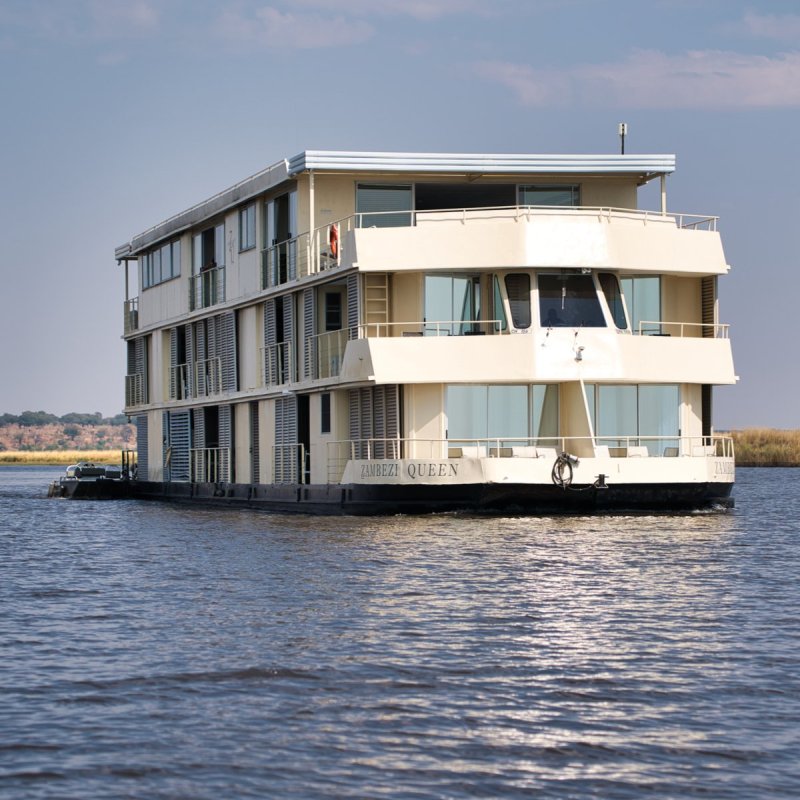
Cruising along the Chobe River with a fresh cocktail in your hand. Waking up and peeking through your curtains to see elephants, hippos, and more. A boat safari, on a floating boutique hotel, is an entirely different experience from a traditional land-based safari. This is a luxury vessel, with three floors, only 14 cabins, and no more than 28 passengers at a time. Classic elegance with modern comforts, a five-star experience in a wild environment.
Videos by TravelAwaits
Navigating roughly 15 miles of the Chobe River, the Zambezi Queen allows you to explore the river and the land from a totally different perspective and be as adventurous or as laid-back as you want. This so much more than just a river cruise; it’s a magical experience, with amazing views over Namibia’s Caprivi Strip on one side and Botswana’s Chobe National Park on the other. You’ll glide down the river as you watch the landscape unfolding and changing before your eyes.
I took my family on the Zambezi Queen in that quiet lull just after the festivities of New Year, when we were looking to relax after all the activity of the so-called silly season. Here are the reasons we recommend you experience the Zambezi Queen yourself.

1. Game Viewing From The River
There is something very special about drifting along a river with wildlife at eye level and almost within arm’s reach. Drinking herds of elephants, temperamental-looking buffaloes, yawning pods of hippos, and solitary, stealthy crocodiles that floated like partially submerged logs or basked on sandbanks in the morning sun. Staying on board the Zambezi Queen is like being on a permanent game viewing vehicle, but with a much higher comfort factor. This is a fantastic way to see wildlife from a completely different angle. The boat cruises slowly down the river, and with the Caprivi Strip on one side and Chobe National Park on the other, you’ll be soaking up plenty of scenery. When we weren’t out on an activity, we relaxed on the top deck, either by the pool or ensconced on one of the comfortable sofas, binoculars close at hand, taking a closer look at anything that drew our attention as we drifted by.
2. Sunsets
Our first evening, moored in Namibian waters as the sun went down, we sat back with one of the delicious cocktails of the day in hand. Admiring the scenery and the dramatic colors of the sky and watching as the glowing orange sun slipped below the horizon. Elephants and hippos were silhouetted against the sky, and the call of a fish eagle, the sound of Africa, echoed across the water. From the top deck, a large open space that houses the bar, lounge, and dining area, large windows provided uninterrupted views of the river as twilight covered the land beyond.
3. Fishing
Waking our first morning on board, the male members of my family opted for a pre-breakfast trip to cast their rods into the water. My family is of the opinion that no river trip is complete without trying your hand at fishing. Never one to stand in their way, but not being an angler myself, I happily waved them off to try their luck. A couple of hours later they were back. The Chobe River is home to the sought-after, ferocious tiger fish, as well as tilapia, African pike, and Zambezi yellowfish. Despite this, my husband and sons between them had only managed to hook a solitary tiger, which had managed to jump off the line, taking the policy of catch and release a little too literally! They returned with all the usual fisherman’s excuses, though I did notice some of the other fishermen hadn’t come back quite so empty-handed.

4. Bird Watching
I chose a more sedate morning activity, a bird-watching trip. Gallinules, rails, crakes, herons, and more flew amongst the floating reed bed islets. Dozens of smaller birds flitted through the undergrowth, their bright, iridescent colors flashing against the foliage. Jacanas strode across rafts of waterlily leaves, each leaf the size of a dinner plate. The slow drift of our tender boat meant we didn’t disturb the peace, and we could get right up close to the birdlife. With over 450 species, the Chobe River is the perfect setting for some rewarding bird-watching.
5. Game Viewing By Tender Boat
Leaving the mother ship by tender boat, that afternoon we went out to get even closer to the wildlife. The dark blue color of the river contrasted with the greens and browns of the bank. Birds swooped past us. Baboon families came down to the water’s edge and drank beside herds of impala and puku. We drifted past elephants, trunks in the water, who paused mid-sip to watch our progress. Kingfishers hovered and plunged in the river, hunting for fish. There was something mesmerizing about the river that afternoon.
6. Game Viewing Without Needing To Leave Your Bed
The soft lapping of water, the muffled grunts of hippos, and the chirping of swallows nesting in the eves just outside my window woke me the next morning. Opening our curtains, before returning to the comfort of a luxurious bed, we watched the Chobe River waking up before our eyes. A couple of hippos bobbed up and down in the water. A small herd of buffalo stared directly at us. Swaying grass on the bank revealed glimpses of camouflaged impala. The beauty of the scene left us speechless.
7. Quadripoint
There are more than 150 tripoints in the world but only one international quadripoint, and here we were, perched precariously, in the top of a 2,000-year-old baobab tree, looking out over the only place in the world where four countries meet. We were on Impalila Island, on the banks of the Chobe River at the eastern tip of the Caprivi Strip, a small slither of land that belongs to Namibia. From our vantage point at the top of the tree, we could see Zimbabwe, Zambia, Botswana, and Namibia as well as the confluence of two great African rivers, the Chobe and Zambezi. Guests on the Zambezi Queen can do a walking tour of Impalila Island, learning about the medicinal and spiritual properties of the island’s flora, and the more adventurous guests can climb the baobab to enjoy the bird’s-eye view.
8. Food And Service
All the meals on the Zambezi Queen were fantastic, but our final dinner on board was the most memorable. Glasses and cutlery glistened in the warm glow of the dining cabin. This was an African-themed dinner with a variety of traditional dishes. Waiters kept our glasses full. Several trips were made by my various family members, back and forth to replenish their plates from the numerous dessert offerings. To finish the night, the entire Zambezi Queen crew sang us a selection of traditional songs to farewell us before our early morning departure the following day.
9. Culture
From the Zambezi Queen, you can travel by tender boat to a local village on the floodplains of Namibia’s Caprivi Strip. Here you meet the villagers and elders of the Subiya tribe and learn how the inhabitants of this 100-year-old village live and some of their traditions. You can pick up a woven basket, some jewelry, or perhaps a carved wooden animal to take home as a memento of your holiday. If you want to, there is an opportunity to give the children useful gifts like school stationery, books, et cetera. To finish off your visit, you can watch (and even join in) a display of traditional dancing and singing.

Pro Tips
Getting There
The Zambezi Queen is ideally located for those wanting to visit the famous Victoria Falls or Chobe National Park.
The Zambezi Queen is accessed by flying into Kasane International Airport. From there, it is a 20-minute road transfer to the Botswana Immigration Post and then a boat trip of around 15 minutes, via Namibian Immigration on the other side of the river, to the Zambezi Queen. A road transfer from Livingstone and Victoria Falls is a journey of two to three hours.
When To Go
The Zambezi Queen sails on scheduled weekly departures every Monday (for two nights or four nights), Wednesday (for two nights), and Friday (for three nights). There are also various specials on offer for honeymooners, last-minute bookings, green season, and land and river trip combos.
Game viewing on the Chobe River is at its best from March to November when the weather is drier and the animals are more mobile as they search for food and water. Summer and spring also offer unique opportunities as you watch the landscape burst into life after the first rains of the season.
Birding season starts in September, when the first migrants arrive, boosting the bird population by 20 percent compared to the winter months. From December through to March, birdlife on the Chobe is extremely busy and the colorful breeding plumage on display is an extraordinary sight.
Fishing safaris can be done all year round. Fishing is especially good from the time the annual floods start in March to the feeding frenzies in the winter months.
Eco Credentials
Several environmentally friendly standards have been set on the Zambezi Queen. The boat runs the latest, most fuel-efficient, and lowest-emission generators during the day. After 10 p.m., the entire boat switches over to battery power through the night. Hot water is provided by a solar heating system on-board the vessel and energy-saving lights are installed throughout the vessel. All cleaning detergents and amenities on the houseboats are biodegradable, and they use an eight-stage river water purification plant for water in showers, taps, and the pool. A water jet propulsion system replaces the conventional propeller system, causing no damage to the riverbed and/or fauna and flora.
